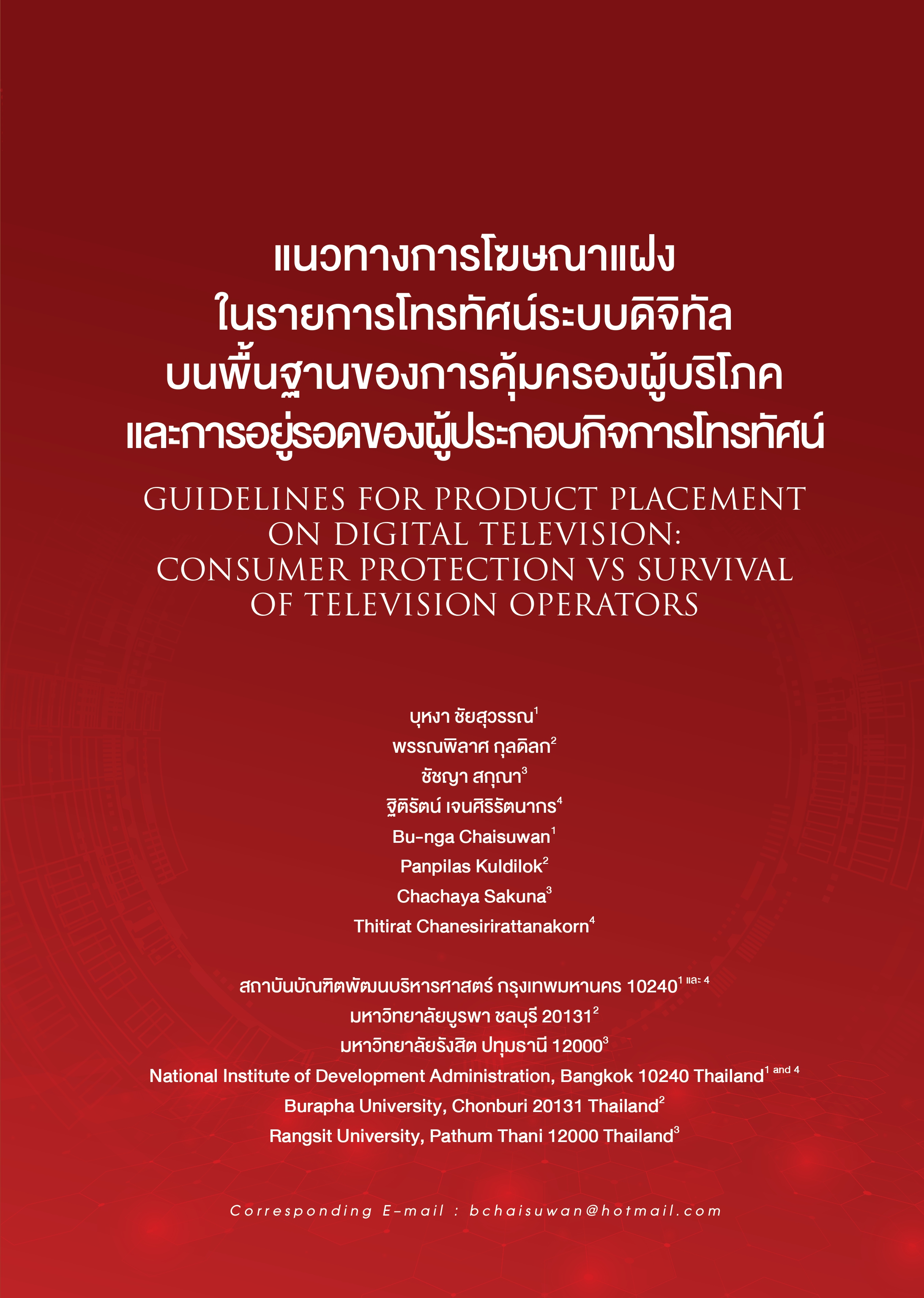แนวทางการโฆษณาแฝงในรายการโทรทัศน์ระบบดิจิทัลบนพื้นฐานของการคุ้มครองผู้บริโภคและการอยู่รอดของผู้ประกอบกิจการโทรทัศน์
คำสำคัญ:
การโฆษณาทางโทรทัศน์ , การโฆษณาแฝง , แนวทางการโฆษณาแฝงในรายการโทรทัศน์ , การคุ้มครองผู้บริโภค , ความอยู่รอดของผู้ประกอบกิจการโทรทัศน์บทคัดย่อ
งานวิจัยนี้ศึกษารูปแบบการโฆษณาแฝงในรายการโทรทัศน์ระบบดิจิทัล ศึกษาความคิดเห็นของผู้มีส่วนได้ส่วนเสียต่อแนวทางการโฆษณาแฝงในรายการโทรทัศน์ระบบดิจิทัล และศึกษาแนวทางการโฆษณาแฝงในรายการโทรทัศน์ระบบดิจิทัลที่สอดคล้องกับการกำกับดูแลของ กสทช. ในมิติของการคุ้มครองผู้บริโภค โดยใช้วิธีวิจัยแบบผสมผสาน ได้แก่ การศึกษาเอกสาร การวิเคราะห์เนื้อหารูปแบบการนำเสนอการโฆษณาแฝง การสัมภาษณ์เชิงลึก การวิจัยเชิงสำรวจ การวิจัยปฏิบัติการทางสังคม และการจัดการประชุมแสดงความคิดเห็น ผลการศึกษาพบว่า รูปแบบการโฆษณาแฝงในรายการโทรทัศน์ระบบดิจิทัลแตกต่างไปจากทฤษฎีในอดีต โดยปัจจุบันแบ่งเป็น 5 กลุ่ม คือ การพูดถึงสินค้า การนำเสนอภาพอย่างเดียว การแสดงประสบการณ์การใช้ การนำเสนอขายสินค้า และ VTR สนับสนุนรายการ สำหรับการนำเสนอโฆษณาแฝงในรายการโทรทัศน์ระบบดิจิทัลที่เหมาะสม ผู้มีส่วนได้ส่วนเสียเห็นว่า ควรพิจารณาวัตถุประสงค์และโครงสร้างรายการ ความต้องการของผู้ชม และนำเสนอเนื้อหาด้วยข้อเท็จจริงของสินค้า นอกจากนั้น ต้องคำนึงถึงระยะเวลาและจำนวนครั้งที่นำเสนอ รวมถึงขนาดภาพด้วย สำหรับแนวทางการโฆษณาแฝงในรายการโทรทัศน์ระบบดิจิทัลที่สอดคล้องกับการกำกับดูแลของ กสทช. ควรพิจารณา 5 องค์ประกอบ คือ ประเภทรายการ ประเภทของสินค้าที่ต้องการโฆษณาแฝง รูปแบบการโฆษณาแฝงทั่วไป รูปแบบการโฆษณาแฝงในรายการโทรทัศน์สำหรับแต่ละประเภทรายการ และการแจ้งเตือนว่ามีการโฆษณาแฝง
เอกสารอ้างอิง
กมลรัฐ อินทรทัศน์. (2557). ทฤษฎีการสื่อสารและเทคโนโลยีสารสนเทศ. นนทบุรี: มหาวิทยาลัยสุโขทัยธรรมาธิราช.
บดินทร์ เดชาบูรณานนท์, ชเณษฎ์นิจ สิทธิวาณิชย์กุล, ชโลมทิพย์ แซ่ตั้ง, พงศกร ภานุมาตรัศมี, อุไรรัช โฉมแก้ว, และ อธิบดี จันทร์ฉาย. (2561). รูปแบบของโฆษณาแฝงและการรับรู้ของผู้ชมในคลับฟรายเดย์เดอะซีรีส์ 7. วารสารมนุษยศาสตร์และสังคมศาสตร์ มหาวิทยาลัยราชพฤกษ์, 4 ฉบับเสริม, 70-81. https://so03.tci-thaijo.org/index.php/rpu/article/view/159611
ผู้จัดการออนไลน์. (2566). เผย 10 มีเดียเทรนด์แรง ทุกแพลตฟอร์มพุ่ง ขับเคลื่อนโฆษณาปี 66.
https://mgronline.com/business/detail/9660000010088
มหาวิทยาลัยราชภัฏอุตรดิตถ์. (2558). รายงานการศึกษาสรุปข้อมูลและสาระสำคัญจากการประชุมและดูงานโครงการพัฒนาองค์ความรู้ด้านการกำกับดูแลกันเอง มาตรฐานจริยธรรมและการส่งเสริมสิทธิเสรีภาพสื่อของประเทศในกลุ่มอาเซียน. สำนักงาน กสทช. https://broadcast.nbtc.go.th/data/academic/file/580700000002.pdf
วิทยาลัยพาณิชยศาสตร์ มหาวิทยาลัยบูรพา. (2562). โครงการศึกษารูปแบบและวิธีการโฆษณาเพื่อจัดทำข้อเสนอแนะต่อการกำกับดูแลการกระทำที่เป็นการเอาเปรียบผู้บริโภคในกิจการกระจายเสียงและโทรทัศน์. สำนักรับเรื่องร้องเรียนและคุ้มครองผู้บริโภคในกิจการกระจายเสียงและโทรทัศน์ (บส.). http://bcp.nbtc.go.th/uploads/items/attachments/a1d33d0dfec820b41b54430b50e96b5c/_402373557f9d12b0df24cb8e59ccc3a6.pdf
วีรพงษ์ พวงเล็ก. (2547). การสำรวจทัศนคติของประชาชนในเขตกรุงเทพมหานครที่มีต่อการโฆษณาสินค้าแฝงในละครโทรทัศน์ [วิทยานิพนธ์วารสารศาสตรมหาบัณฑิต]. มหาวิทยาลัยธรรมศาสตร์. https://digital.library.tu.ac.th/tu_dc/frontend/Info/item/dc:114623
สำนักงานคณะกรรมการกิจการกระจายเสียง กิจการโทรทัศน์ และกิจการโทรคมนาคมแห่งชาติ (2559ก). พระราชบัญญัติการประกอบกิจการกระจายเสียงและกิจการโทรทัศน์ พ.ศ.2551. https://www.nbtc.go.th/Business/กจการวทย/เอกสารที่เกี่ยวข้อง-(1)/กฎหมาย-(1)/พระราชบัญญัติการประกอบกิจการกระจายเสียงและกิจการโท.aspx?lang=th-TH
สำนักงานคณะกรรมการกิจการกระจายเสียง กิจการโทรทัศน์ และกิจการโทรคมนาคมแห่งชาติ (2554). ประกาศ กสทช. เรื่อง การกระทำที่เป็นการเอาเปรียบผู้บริโภคในกิจการกระจายเสียงและกิจการโทรทัศน์ พ.ศ. 2555. https://www.nbtc.go.th/Business/กจการวทย/เอกสารที่เกี่ยวข้อง-(1)/กฎหมาย-(1)/ประกาศ-กสทช-เรื่อง-การกระทำที่เป็นการเอาเปรียบผู้บ.aspx?lang=th-TH
อาภาพร อุดมพืช. (2553). วิเคราะห์ลักษณะโฆษณาแฝงที่ปรากฏในรายการโทรทัศน์ไทย. วารสารวิชาการมหาวิทยาลัยฟาร์อีสเทอร์น, 3(2), 82-90.
https://so01.tci-thaijo.org/index.php/FEU/article/view/26841
Corkindale, D., Neale, M., & Bellman, S. (2021). Product Placement and Integrated Marketing Communications Effects on an Informational TV Program. Journal of Advertising, 52(1), 75–93. https://doi.org/10.1080/00913367.2021.1981500
d’Astous, A., & Seguin, N. (1999). Consumer reactions to product placement strategies in television sponsorship. European journal of Marketing, 33(9/10), 896-910. https://doi.org/10.1108/03090569910285832
Drumwright, M. E., & Murphy, P. E. (2009). The Current State of Advertising Ethics: Industry and Academic Perspectives. Journal of Advertising, 38(1), 83-108. https://doi.org/10.2753/JOA0091-3367380106
Fleiss, J. L., Levin, B., & Paik, M. C. (2003). Statistical methods for rates and proportions (3rd ed.). John Wiley & Sons.
KARRH, J. A., McKEE, K. B., & PARDUN, C. J. (2003). Practitioners’ Evolving Views on Product Placement Effectiveness. Journal of Advertising Research, 43(2), 138-149. https://doi.org/10.1017/S0021849903030198
Lee, M., Kim, K. & King, K. W. (2012). Audience Responses to Product Placement and Its Regulations: Focusing on Regulatory Conditions in the United States and Korea. Journal of International Consumer Marketing, 24(4). 275-290. https://doi.org/10.1080/08961530.2012.728505
McKechnie, S. A. & Zhou, J. (2003). Product placement in movies: a comparison of Chinese and American consumers’ attitudes. International Journal of Advertising, 22(3), 349-374, https://doi.org/10.1080/02650487.2003.11072858
Qu, Z., Yang, N., & Zhang, J. (2024). A Compendium of Research on the Impact of Product Placement on Consumer Buying Behaviour. Highlights in Business, Economics and Management, 27, 226-232. https://doi.org/10.54097/mvzmfy31
Shears, P. (2014). Product Placement: The UK and the New Rules. Journal of Promotion Management, 20(1), 59-81. https://doi.org/10.1080/10496491.2013.802478
Smit, E., Reijmersdal, V. E., & Neijens, P. (2009). Today’s practice of brand placement and the industry behind it. International Journal of Advertising, 28(5), 761-782. https://doi.org/10.2501/S0265048709200898
TV Digital Watch. (2022). เรตติ้งช่องโทรทัศน์ดิจิทัลไตรมาสแรกปี 2565. https://www.tvdigitalwatch.com/rating3group-1st-trimas65/
Ofcom. (2023). The Ofcom Broadcasting Code (with the Cross-promotion Code and the On Demand Programme Service Rules). https://www.ofcom.org.uk/tv-radio-and-on-demand/broadcast-codes/broadcast-code

ดาวน์โหลด
เผยแพร่แล้ว
รูปแบบการอ้างอิง
ฉบับ
ประเภทบทความ
สัญญาอนุญาต
ลิขสิทธิ์ (c) 2024 วารสารกิจการสื่อสารดิจิทัล

อนุญาตภายใต้เงื่อนไข Creative Commons Attribution-NonCommercial-NoDerivatives 4.0 International License.
บทความที่ปรากฏในวารสารกิจการสื่อสารดิจิทัล เป็นลิขสิทธิ์ของสำนักงาน กสทช. ซึ่งสำนักงาน กสทช. เปิดโอกาสให้สาธารณะหรือบุคคลทั่วไปสามารถนำผลงานไปเผยแพร่ คัดลอก หรือตีพิมพ์ซ้ำได้ ภายใต้สัญญาอนุญาตแบบเปิด (Creative Commons: CC) โดยมีเงื่อนไขสำหรับผู้ที่นำผลงานไปใช้ต้องระบุอ้างอิงแหล่งที่มา (Attribution: BY) ห้ามดัดแปลง (NoDerivatives: ND) และต้องไม่ใช้เพื่อการค้า (NonCommercial: NC) เว้นแต่ได้รับอนุญาตเป็นลายลักษณ์อักษรจากสำนักงาน กสทช.
อนึ่ง ข้อความ ตาราง และภาพที่ปรากฏในบทความซึ่งได้รับการตอบรับให้ตีพิมพ์และเผยแพร่ในวารสารนี้เป็นความคิดเห็นของผู้นิพนธ์ โดยไม่ผูกพันต่อ กสทช. และสำนักงาน กสทช. หากมีความผิดพลาดใด ๆ ผู้นิพนธ์แต่ละท่านต้องรับผิดชอบบทความของตนเองแต่เพียงผู้เดียว ไม่เกี่ยวข้องกับ กสทช. และสำนักงาน กสทช. แต่ประการใด


